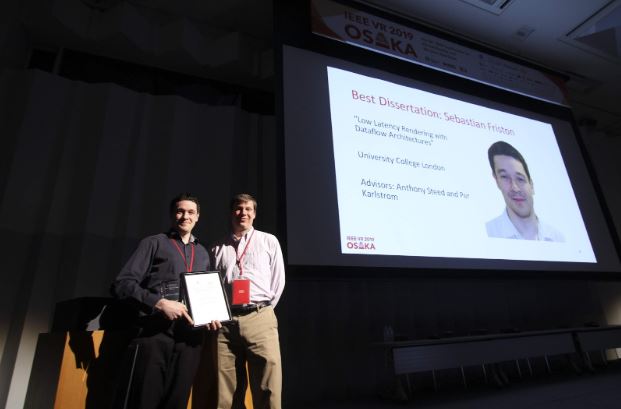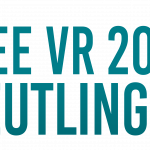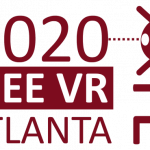UCL at IEEE VR2019
IEEE VR 2019 was in Osaka. It was a chance for Anthony, who was on sabbatical in New Zealand at the time, to meet up with a couple of people in the group — Drew and Sebastian — who came out from London, and recent graduate Maria who was now working at Facebook/Oculus.
Sebastian won the 2018 VGTC Virtual Reality Best Dissertation Award for his dissertation on Low Latency Rendering with Dataflow Architectures. He gave a short talk about his work.

Drew presented his paper Perception of Volumetric Characters’ Eye-Gaze Direction in Head-Mounted Displays.
Abstract: Volumetric capture allows the creation of near-video-quality content that can be explored with six degrees of freedom. Due to limitations in these experiences, such as the content being fixed at the point of filming, an understanding of eye-gaze awareness is critical. A repeated measures experiment was conducted that explored users’ ability to evaluate where a volumetrically captured avatar (VCA) was looking. Wearing one of two head-mounted displays (HMDs), 36 participants rotated a VCA to look at a target. The HMD resolution, target position, and VCA’s eye-gaze direction were varied. Results did not show a difference in accuracy between HMD resolutions, while the task became significantly harder for target locations further away from the user. In contrast to real-world studies, participants consistently misjudged eye-gaze direction based on target location, but not based on the avatar’s head turn direction. Implications are discussed, as results for VCAs viewed in HMDs appear to differ from face-to-face scenarios

Anthony gave a keynote speech at PERCAR: The Fifth IEEE VR Workshop on Perceptual and Cognitive Issues in AR. He talked about Embodied Cognition in AR/VR.
Here is one of the official photographers photos of Drew talking.


Showing a video from one of the VR group’s early experiments, circa 1994.

Anthony gave an invited talk on The Impact of Avatars on Close Quarters Interaction at the Virtual Humans and Crowds in Immersive Environments (VHCIE)
Abstract: There is a compelling theory emerging of how embodiment inside immersive virtual environments enables participants to use their bodies in natural and fluid ways. In this talk, I will discuss recent work on how avatar representation and embodiment affect collaboration in social virtual reality. Our lab-based works shows how users utilize information about avatars in quite complex and surprising ways, and our studies of consumers in their homes shows some of the barriers that users experience in using avatars for extended periods. I will then discuss how these set some near-term challenges to the field, and review some immediate ways forward that could have significant impact on the utility of social virtual reality.

We had a poster about some work I helped with during my stay at Microsoft, with Mar Gonzales and Parastoo Abtahi: Individual Differences in Embodied Distance Estimation in Virtual Reality

Finally, Anthony was on a panel about Virtual Reality Curriculum.




